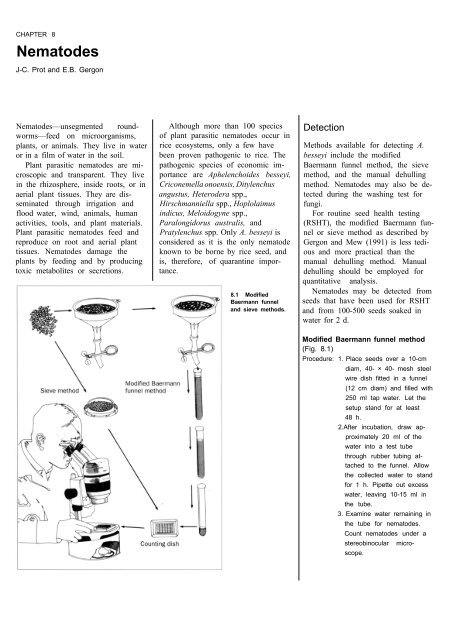A manual of rice seed health testing - IRRI books - International Rice ...
A manual of rice seed health testing - IRRI books - International Rice ...
A manual of rice seed health testing - IRRI books - International Rice ...
- No tags were found...
You also want an ePaper? Increase the reach of your titles
YUMPU automatically turns print PDFs into web optimized ePapers that Google loves.
CHAPTER 8<br />
Nematodes<br />
J-C. Prot and E.B. Gergon<br />
Nematodes—unsegmented roundworms—feed<br />
on microorganisms,<br />
plants, or animals. They live in water<br />
or in a film <strong>of</strong> water in the soil.<br />
Plant parasitic nematodes are microscopic<br />
and transparent. They live<br />
in the rhizosphere, inside roots, or in<br />
aerial plant tissues. They are disseminated<br />
through irrigation and<br />
flood water, wind, animals, human<br />
activities, tools, and plant materials.<br />
Plant parasitic nematodes feed and<br />
reproduce on root and aerial plant<br />
tissues. Nematodes damage the<br />
plants by feeding and by producing<br />
toxic metabolites or secretions.<br />
Although more than 100 specics<br />
<strong>of</strong> plant parasitic nematodes occur in<br />
<strong>rice</strong> ecosystems, only a few have<br />
been proven pathogenic to <strong>rice</strong>. The<br />
pathogenic species <strong>of</strong> economic importance<br />
are Aphelenchoides besseyi,<br />
Criconemella onoensis, Ditylenchus<br />
angustus, Heterodera spp.,<br />
Hirschmanniella spp., Hoplolaimus<br />
indicus, Meloidogyne spp.,<br />
Paralongidorus australis, and<br />
Pratylenchus spp. Only A. besseyi is<br />
considered as it is the only nematode<br />
known to be borne by <strong>rice</strong> <strong>seed</strong>, and<br />
is, therefore, <strong>of</strong> quarantine importance.<br />
8.1 Modified<br />
Baermann funnel<br />
and sieve methods.<br />
Detection<br />
Methods available for detecting A.<br />
besseyi include the modified<br />
Baermann funnel method, the sieve<br />
method, and the <strong>manual</strong> dehulling<br />
method. Nematodes may also be detected<br />
during the washing test for<br />
fungi.<br />
For routine <strong>seed</strong> <strong>health</strong> <strong>testing</strong><br />
(RSHT), the modified Baermann funnel<br />
or sieve method as described by<br />
Gergon and Mew (1991) is less tedious<br />
and more practical than the<br />
<strong>manual</strong> dehulling method. Manual<br />
dehulling should be employed for<br />
quantitative analysis.<br />
Nematodes may be detected from<br />
<strong>seed</strong>s that have been used for RSHT<br />
and from 100-500 <strong>seed</strong>s soaked in<br />
water for 2 d.<br />
Modified Baermann funnel method<br />
(Fig. 8.1)<br />
Procedure: 1. Place <strong>seed</strong>s over a 10-cm<br />
diam, 40- × 40- mesh steel<br />
wire dish fitted in a funnel<br />
(12 cm diam) and filled with<br />
250 ml tap water. Let the<br />
setup stand for at least<br />
48 h.<br />
2.After incubation, draw approximately<br />
20 ml <strong>of</strong> the<br />
water into a test tube<br />
through rubber tubing attached<br />
to the funnel. Allow<br />
the collected water to stand<br />
for 1 h. Pipette out excess<br />
water, leaving 10-15 ml in<br />
the tube.<br />
3. Examine water rernaining in<br />
the tube for nematodes.<br />
Count nematodes under a<br />
stereobinocular microscope.

















